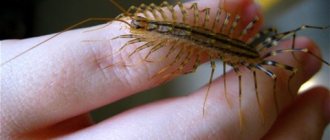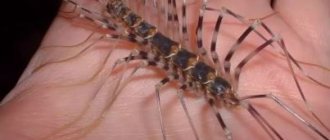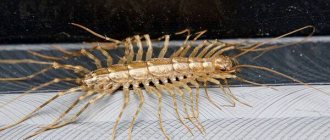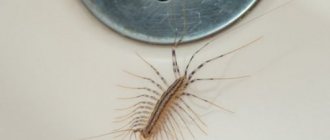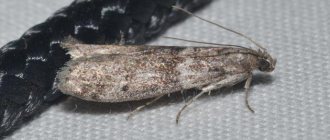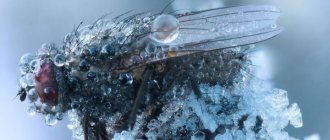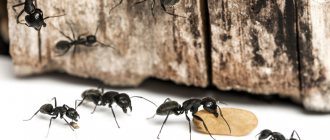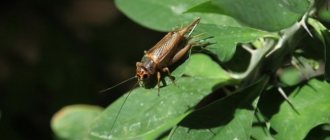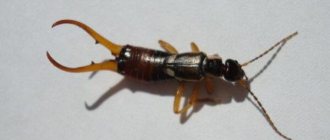The tactics for dealing with centipedes at home and on the street are somewhat different. First, let's put together a guide on how to get rid of house centipedes. To combat house centipedes, there are several very effective approaches that can also be used against other representatives of this superclass - centipedes.
Then we'll talk about how to get uninvited guests out of your garden. And finally, we will select the 5 best remedies that will allow you to forget about the invasion of these creatures.
Who are the centipedes in the house?
Centipedes, millipedes or millipedes are representatives of invertebrates.
Scolopendra.
These are mostly predators that feed on small insects, garden pests, ants, reptiles and even small rodents.
They love warm and humid places, so most of them live in the tropics and subtropics. In Russia they live mainly in the south.
Appearance and body structure
Due to their characteristic appearance, centipedes have long been classified as insects. However, research has shown that these groups are not homogeneous, although they have a common ancestor.
The length of centipedes varies widely: from 2 mm to 40 centimeters. In regions with a warm climate, for example, in the Crimea, you can find quite large individuals, for example, Crimean hawks, whose body size reaches 4 cm. In areas with a cool climate, small representatives of the superclass are found.
The body of centipedes is segmented. The head consists of 4 or 5 segments. The body is not divided into sections and also consists of homogeneous segments.
The main feature of centipedes, which gave rise to their name, is the number of legs: individual representatives can have up to 750 of them. Interestingly, the number of pairs of legs is never even.
The color of centipedes can be black, reddish, or ocher. The younger the individual, the lighter the shade it has.
Habitats of centipedes
Insects are ubiquitous in a house or apartment. However, encountering centipedes when the lights suddenly turn on will not be pleasant. Especially considering the speed and impressive views of this animal.
You can meet them:
- In bathroom;
- near a pond;
- under stones;
- in the trunks of rotting trees;
- places where litter is collected;
- compost pits;
- cellars;
- garages.
Reproduction
Centipedes lead a solitary lifestyle. In May and June they begin their breeding season. At this time, females begin to produce pheromones that attract males.
The fertilization process of centipedes is interesting. First, the male blocks the entrance to his home in the soil and deposits a sac with sperm - a spermatophore - into the resulting shelter. After this, the female crawls under the spermatophore, capturing it with her genital appendage. A few days later she lays eggs in the hole. The female creates a layer of sticky mucus on top of the eggs, which protects the offspring from predators.
One clutch can contain from 60 to 150 eggs. The female does not leave the clutch and drives other insects away from it. To prevent mold from appearing on the eggs, the centipede secretes a special substance whose composition resembles antifungal drugs.
Centipede larvae emerge simultaneously.
Varieties of centipedes
There are no species of centipedes that are adapted to life in the house. They go there in search of reliable shelter and sufficient food. There are several common species that live in houses and apartments.
This living creature looks unpleasant, it is small, but has thin curved legs. This insect is the leader in movement speed. This is an excellent house cleaner. It feeds on flies, cockroaches, fleas and other small insects.
flycatcher
A large number of species of this insect can be found everywhere. These are predators that actively eat many insects. They are not dangerous to humans, but they can bite unpleasantly and their venom is irritating.
Scolopendra
Prevention of occurrence
The main preventive measures include maintaining a high level of sanitary and hygienic condition of the premises. You simply won’t want to live in an apartment with an acceptable level of humidity, no accumulations of insects, or centipedes.
Additionally required:
- Eliminate possible “passages” through which insects can get into the living space. Caulk cracks in the walls and floors, install mosquito nets on the windows, coat the baseboards in the bathrooms with silicone glue.
- Carry out preventive treatment with insecticides of access routes to the premises that cannot be completely eliminated (for example, ventilation openings).
- If the level of humidity in the apartment is still high, ventilate it more often, remove a large number of house plants that require frequent watering, and do not dry clothes in the rooms after washing.
Compliance with these simple measures will protect your apartment from centipede invasion.
How to get rid of centipedes in the house
If a nimble creature with a huge number of legs that moves almost at lightning speed is noticed in a room when the light suddenly turns on, grabbing a slipper will not help. It’s impossible to keep up with them, and it’s also difficult to kill many of them.
Make your home uncomfortable
The very first rule that will help get rid of centipedes in the house is to make it uncomfortable for them to exist. Here are some ways to help eliminate the settlement of living creatures:
- Remove insects that are of interest to centipedes. No food - no point in living indoors.
Centipede on the site.
- Remove dampness and places of stagnant moisture. High humidity is a comfortable place for animals.
- Monitor the condition of pipes, repair holes, update building materials and paintwork.
- Monitor the state of affairs in the cellar, attic and area, in all places where centipedes can live comfortably.
Traditional methods of getting rid of insects
The problem is that insects are not interested in simple food and will not bite on bait. You can, of course, spray or feed the insects that will become food with chemicals, but this is unlikely.
There are a number of drugs that will help remove centipedes. These baits will make their life unbearable; they act poisonously, even if they touch the body of the centipedes.
Sprinkle in places of residence:
- boric acid;
- Cayenne pepper.
Mechanical method
If possible, the centipede can be caught in a jar or sucked up with a vacuum cleaner. The further future is up to the person to decide - to kill or take the animal outside the site.
A good way to catch animals is sticky tape. It is laid out along the paths along which the scary roommates move. Even 30 pairs of legs will not save the animal from this trap.
Eliminate moisture
The main reason why centipedes appear in the house is the abundance of moisture. Once you get rid of it, the flycatchers will leave to look for a more suitable place to live. Therefore, it is necessary to carry out general cleaning and carefully inspect hard-to-reach places (behind the bathtub, toilet and under sinks). There may be water accumulating somewhere or a wet rag lying around. All wet areas should be wiped dry. Do not allow condensation to form on pipes or walls. This can often be observed after bath procedures. You should ventilate the bathroom and wipe the floor more often. If necessary, you can use a heater to dry the air. Wet towels and floor rags must not be left in the house. It is better to dry them outside or on an open balcony. It is also worth taking a closer look at the condition of the basement and attic. If water accumulation is found there, you will have to call a plumber.
How to get rid of centipedes on your property
Animals that live outside the house will not harm people. Only a meeting with a scolopendra can be dangerous. To deal with them you will need:
Scolopendras are unpleasant neighbors.
- Clean greenhouses and wood storage areas.
- Look in and move large stones and boulders.
- Check silage heaps and compost pits.
- Clear the house of rags and debris.
Is it worth destroying?
If order has been restored on the site and the yard has been cleared, the question will arise whether it is necessary to get rid of the centipedes. They eat garden pests, working for the benefit of gardeners.
There is a version that centipedes are garden pests. But even in the hungriest year, they prefer to move to other places in search of food rather than change their taste preferences.
Modern means
Many modern people also know how to get rid of centipedes in the house. To do this, they use toxic drugs that destroy not only the flytrap, but also other uninvited guests that it attracts. Since such products belong to the category of strong chemicals, it is necessary to take safety measures. During processing, you should wear a mask and gloves, and after finishing work, ventilate the room.
The following drugs are suitable to combat flycatchers:
- "Dichlorvos Neo". Available in aerosol form, which is odorless. It kills centipedes almost instantly. The effect of the drug lasts for two weeks.
- "Raid". Also presented in the form of a spray, but with the scent of lavender. Continues to work for several days after treating the room. The product must be ventilated.
- "Medilis-Ziper". This is a rather toxic product that needs to be sprayed on the intended habitat of centipedes. The drug stands out from the rest because it does not harm pets.
- "Clean house". This product is more suitable for destroying centipede nests. But it also effectively copes with other pests.
- "Global". It is a toxic paste for killing various pests. It must be applied to arthropod habitats and around the perimeter of the room. The smell of the paste is unpleasant, but weak.
Nutrition and reproduction
The common centipede is a carnivorous predator that hunts pests: flies, ants, cockroaches, fleas, bedbugs. In nature, large individuals also feed on small lizards, frogs, spiders, and worms.
When attacking, she uses her front jaws, which are connected to poison glands. Having bitten the victim, the flycatcher paralyzes it and gradually eats it. Having caught several insects at once, the house flycatcher eats them one by one, holding the rest with its numerous legs.
Interesting!
The toxins released by the centipede have a pungent odor that repels other predators. Therefore, even after killing a flycatcher, not every animal will want to eat it.
Centipedes reproduce in a very original way. At the right time, males, when meeting a female, deposit a lemon-shaped spermatophore, then push the female towards it, which picks it up with her appendages. Then the female lays 50-60 eggs, protected with a special sticky composition, into the prepared hole. After which the mother flycatcher sits with her whole body on the clutch and waits for her offspring to mature. “Hatching” the eggs lasts several weeks, and all this time the female does not leave the nest, practically starving.
The hatched babies are white or transparent in color and have 4 pairs of legs; their number will subsequently increase to 15 after each regular molt, when the arthropods shed the old chitinous shell and acquire a new one. Life expectancy is 3-7 years.
Important!
Centipede venom is not dangerous to humans. The only exceptions are those who are prone to allergic reactions to insect bites. The bite site may become slightly swollen and their temperature may rise. Centipedes do not tolerate any infections.
The homeland of these arthropods is the northern regions of Africa, the Middle East, and southern Europe. There are several hundred species of centipedes in the world, many of which have not yet been studied by biologists. In the CIS, insects similar to centipedes can be found in the southern regions of Russia, the Caucasus, Crimea, and Kazakhstan.

